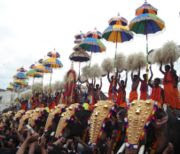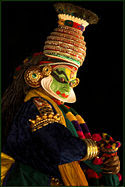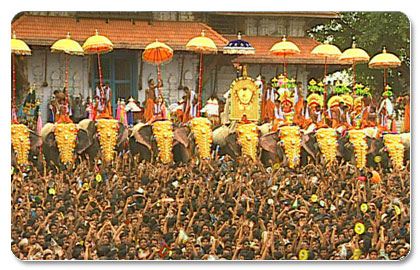Arts of Kerala and Culture of Kerala
Kerala's culture is a blend of Dravidian and Aryan influences, deriving from both a greater Tamil-heritage region known as Tamilakam and southern coastal Karnataka. Later, Kerala's culture was elaborated upon through centuries of contact with neighboring and overseas cultures. Native performing arts include koodiyattom, kathakali—from katha ("story") and kali ("performance")—and its offshoot Kerala natanam, koothu (akin to stand-up comedy), mohiniaattam ("dance of the enchantress"), thullal, padayani, and theyyam.
 Thrissur Pooram
Thrissur PooramA formation of gold-caparisoned elephants at the Thrissur Pooram. Poorams are Hindu temple-centered festivals popular among both Keralites and tourists.
Other forms of art are more religious or tribal in nature. These include chavittu nadakom, oppana (originally from Malabar), which combines dance, rhythmic hand clapping, and ishal vocalisations. However, many of these art forms largely play to tourists or at youth festivals, and are not as popular among most ordinary Keralites. These people look to more contemporary art and performance styles, including those employing mimicry and parody.
Kathakali
A close-up of a kathakali artist.
Kerala's music also has ancient roots. Carnatic music dominates Keralite traditional music. This was the result of Swathi Thirunal Rama Varma'ssopanam accompany kathakali performances. Melam (including the paandi and panchari variants) is a more percussive style of music; it is performed at Kshetram centered festivals using the chenda. Melam ensembles comprise up to 150 musicians, and performances may last up to four hours. Panchavadyam is a different form of percussion ensemble, in which up to 100 artists use five types of percussion instrument. Kerala has various styles of folk and tribal music. The popular music of Kerala is dominated by the filmi music of Indian cinema. Kerala's visual arts range from traditional murals to the works of Raja Ravi Varma, the state's most renowned painter.
Onam
During Onam, Keralites create floral pookkalam designs in front of their houses.
Kerala has its own Malayalam calendar, which is used to plan agricultural and religious activities. Kerala's cuisine is typically served as a sadhya on green banana leaves. Such dishes as idli, payasam, pulisherry, puttucuddla, puzhukku, rasam, and sambar are typical. Keralites—both men and women alike—traditionally don flowing and unstitched garments. These include the mundu, a loose piece of cloth wrapped around men's waists. Women typically wear the sari, a long and elaborately wrapped banner of cloth, wearable in various styles.


